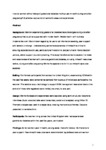How do women with a history of gestational diabetes mellitus use mHealth during and after pregnancy? Qualitative exploration of women's views and experiences
| dc.contributor.author | Edwards, K | |
| dc.contributor.author | Bradwell, Hannah | |
| dc.contributor.author | Jones, Ray | |
| dc.contributor.author | Andrade, Jackie | |
| dc.contributor.author | SHAWE, JILL | |
| dc.date.accessioned | 2021-03-25T17:54:19Z | |
| dc.date.issued | 2021-03-21 | |
| dc.identifier.issn | 0266-6138 | |
| dc.identifier.issn | 1532-3099 | |
| dc.identifier.other | 102995 | |
| dc.identifier.uri | http://hdl.handle.net/10026.1/16983 | |
| dc.description.abstract |
BACKGROUND: Women experiencing gestational diabetes face challenges during and after pregnancy that could be supported with mobile health. Mobile health isn't routinely implemented and little is known regarding its use to aid information seeking, peer support and behaviour change. Understanding women's experiences of mHealth is critical to ensuring acceptance and use, particularly with relation to postpartum and interconception periods, where support is currently lacking. This study therefore aimed to explore the views and experiences of women with previous gestational diabetes, on using mHealth resources before, during and after pregnancy.Women's expectations for future mHealth were also explored. SETTING: Ten female participants from across the United Kingdom, experiencing GDM within the past five years, were convenience sampled from a group of individuals participating in a webinar. The webinar about technology to support GDM management was advertised online and all of those who registered were invited, via email, to take part. DESIGN: Women's views and experiences were explored using semi-structured telephone interviews. Audio recorded data were transcribed, coded and analysed using NVivo 12. Thematic analysis was used to analyse data, creating main and sub-themes. Data are presented in narrative form. PARTICIPANTS: Ten women living across the United Kingdom who had experienced gestational diabetes within the past five years, participated. FINDINGS: All ten women used mHealth, valuing social media for dietary information and peer support. Few mHealth resources were recommended by professionals and women discussed discontentment with the information they provided. Information found online was often valued over that provided by professionals. Some women used apps for behaviour change, but disliked certain features and poor engagement hindered their use. Women desired an app to overcome lack of motivation and prepare them for future healthy pregnancies. KEY CONCLUSIONS: Information provided to women by professionals was viewed as 'limited' and mHealth resources were rarely recommended. In response, women used social media to meet informational and emotional needs. Postpartum behaviour change is important to women and could be facilitated with tailored mHealth focused on increasing motivation. To maximise adoption and engagement future mHealth should be integrated with existing resources women value and be co-produced with professionals. IMPLICATIONS FOR PRACTICE: Current lack of engagement in mHealth for GDM by healthcare professionals means opportunities to influence or contest poor information are missed. We recommend increased participation by professionals to reduce opportunities for information miss-spread and reliance on peer driven information. Increasing digital confidence among professionals to support women navigate online spaces and take part in co-design is recommended. | |
| dc.format.extent | 102995-102995 | |
| dc.format.medium | Print-Electronic | |
| dc.language | en | |
| dc.language.iso | en | |
| dc.publisher | Elsevier | |
| dc.subject | Gestational diabetes mellitus | |
| dc.subject | mHealth | |
| dc.subject | Social media | |
| dc.subject | Qualitative research | |
| dc.subject | Interviews | |
| dc.subject | Women's health | |
| dc.title | How do women with a history of gestational diabetes mellitus use mHealth during and after pregnancy? Qualitative exploration of women's views and experiences | |
| dc.type | journal-article | |
| dc.type | Journal Article | |
| plymouth.author-url | https://www.webofscience.com/api/gateway?GWVersion=2&SrcApp=PARTNER_APP&SrcAuth=LinksAMR&KeyUT=WOS:000654352300001&DestLinkType=FullRecord&DestApp=ALL_WOS&UsrCustomerID=11bb513d99f797142bcfeffcc58ea008 | |
| plymouth.volume | 98 | |
| plymouth.publication-status | Published | |
| plymouth.journal | Midwifery | |
| dc.identifier.doi | 10.1016/j.midw.2021.102995 | |
| plymouth.organisational-group | /Plymouth | |
| plymouth.organisational-group | /Plymouth/Admin Group - REF | |
| plymouth.organisational-group | /Plymouth/Admin Group - REF/REF Admin Group - FoH | |
| plymouth.organisational-group | /Plymouth/Faculty of Health | |
| plymouth.organisational-group | /Plymouth/Faculty of Health/School of Nursing and Midwifery | |
| plymouth.organisational-group | /Plymouth/Faculty of Health/School of Psychology | |
| plymouth.organisational-group | /Plymouth/REF 2021 Researchers by UoA | |
| plymouth.organisational-group | /Plymouth/REF 2021 Researchers by UoA/UoA03 Allied Health Professions, Dentistry, Nursing and Pharmacy | |
| plymouth.organisational-group | /Plymouth/REF 2021 Researchers by UoA/UoA04 Psychology, Psychiatry and Neuroscience | |
| plymouth.organisational-group | /Plymouth/REF 2021 Researchers by UoA/UoA04 Psychology, Psychiatry and Neuroscience/UoA04 REF peer reviewers | |
| plymouth.organisational-group | /Plymouth/Research Groups | |
| plymouth.organisational-group | /Plymouth/Research Groups/Centre for Brain, Cognition and Behaviour (CBCB) | |
| plymouth.organisational-group | /Plymouth/Research Groups/Centre for Brain, Cognition and Behaviour (CBCB)/Cognition | |
| plymouth.organisational-group | /Plymouth/Research Groups/Institute of Health and Community | |
| plymouth.organisational-group | /Plymouth/Research Groups/Plymouth Institute of Health and Care Research (PIHR) | |
| plymouth.organisational-group | /Plymouth/Users by role | |
| plymouth.organisational-group | /Plymouth/Users by role/Academics | |
| dc.publisher.place | Scotland | |
| dcterms.dateAccepted | 2021-03-18 | |
| dc.rights.embargodate | 2022-3-21 | |
| dc.identifier.eissn | 1532-3099 | |
| dc.rights.embargoperiod | Not known | |
| rioxxterms.versionofrecord | 10.1016/j.midw.2021.102995 | |
| rioxxterms.licenseref.uri | http://www.rioxx.net/licenses/all-rights-reserved | |
| rioxxterms.licenseref.startdate | 2021-03-21 | |
| rioxxterms.type | Journal Article/Review |


